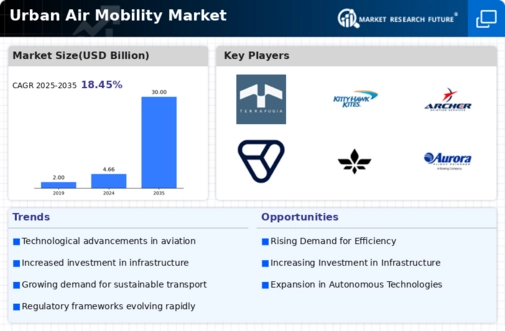Top Industry Leaders in the Urban Air Mobility Market

Strategies Adopted: Key players in the Urban Air Mobility Market are deploying various strategies to establish themselves and gain a competitive edge. These strategies include:
Technological Innovation: Companies are investing heavily in research and development to advance electric propulsion systems, autonomous flight technology, and air traffic management systems to ensure safe, efficient, and sustainable urban air transportation.
Strategic Partnerships: Collaborations with regulators, city authorities, infrastructure providers, and ecosystem partners are crucial for navigating regulatory hurdles, securing landing sites, and integrating UAM operations into existing transportation networks.
Demonstration Projects: Conducting demonstration flights, pilot programs, and public trials helps companies showcase the viability and benefits of UAM solutions to potential customers, investors, and the general public, building trust and generating demand.
Customer Engagement: Engaging with potential users, urban planners, policymakers, and stakeholders through education, outreach, and community involvement initiatives is essential for understanding market needs, addressing concerns, and shaping favorable regulatory environments.
Strategies Adopted By Key Players Urban Air Mobility (UAM) Market
Airbus Group (France)
Boeing (US)
Volocopter GmbH (Germany)
Honeywell International Inc. (US)
Aurora Flight Sciences (US)
Embraer SA (Brazil)
PIPISTREL (Slovenia)
Bell Helicopter Textron Inc. (US)
Neva Aerospace (UK)
Delorean Aerospace LLC (US)
Kitty Hawk (US)
Lilium (Germany)
EHang (China)
Workhorse Group Inc. (US)
Joby Aviation (US)
Factors for Market Share Analysis: Several factors influence market share analysis in the Urban Air Mobility Market, including:
Technology Leadership: Companies with a strong technological foundation, innovative solutions, and intellectual property rights have a competitive advantage in shaping the future of urban air transportation.
Regulatory Approval: Obtaining regulatory approvals, certifications, and airspace access permissions from aviation authorities is critical for launching commercial UAM operations and gaining market share in different regions.
Fleet Size and Scalability: The size, scalability, and deployment readiness of UAM fleets play a crucial role in meeting market demand, servicing multiple routes, and capturing a larger share of the urban mobility market.
Customer Adoption and Experience: Positive user experiences, safety records, and affordability are key drivers of customer adoption and loyalty, influencing market share and brand perception in the competitive UAM landscape.
New and Emerging Companies: In addition to established players, new and emerging companies are entering the Urban Air Mobility Market, bringing innovative technologies and business models. These companies often focus on niche segments or disruptive approaches, challenging traditional players and driving innovation in the industry. Some notable new and emerging companies in the market include:
Joby Aviation
Lilium GmbH
Vertical Aerospace
Archer Aviation
EHang Holdings Limited
Volocopter GmbH
Kitty Hawk Corporation
Wisk Aero LLC
Beta Technologies, Inc.
Industry News and Current Investment Trends: Recent developments and investment trends in the Urban Air Mobility Market reflect a growing interest in electric vertical takeoff and landing (eVTOL) aircraft, infrastructure development, and regulatory advancements. Key highlights include:
Investment Influx: Venture capital funding, corporate investments, and government grants are pouring into UAM startups and technology providers to accelerate product development, certification efforts, and market deployment.
Infrastructure Development: Companies and governments are investing in vertiports, charging stations, air traffic management systems, and urban airspace integration infrastructure to support the growth of UAM operations in cities worldwide.
Regulatory Progress: Aviation regulators are working closely with industry stakeholders to develop certification standards, airworthiness requirements, and operational guidelines for UAM operations, paving the way for commercialization and market expansion.
Partnerships and Acquisitions: Strategic partnerships, joint ventures, and acquisitions among UAM companies, aerospace manufacturers, technology firms, and mobility providers are reshaping the competitive landscape and driving collaboration across the ecosystem.
Overall Competitive Scenario: The Urban Air Mobility Market is experiencing intense competition fueled by technological innovation, regulatory developments, and market demand for sustainable urban transportation solutions. Established players leverage their expertise, resources, and industry partnerships to lead the market, while new entrants disrupt traditional paradigms with novel approaches and business models. As the industry matures, companies that focus on safety, reliability, scalability, and customer-centricity will thrive in the competitive landscape of the Urban Air Mobility Market.
Urban Air Mobility Industry Developments
January 2023:
In a move towards bringing electric vertical take-off and landing (eVTOL) cars to market, Geely Aerofugia, a division of the Chinese manufacturer Geely, has completed a test flight of its flying car prototype, the AE200. In August 2022, this business debuted a full-size demonstration of its five-seater eVTOL, the TF-2.
September 2021:
Trinity Air Medical Inc. was purchased by US-based Blade Air Mobility Inc. for $23 million. With this acquisition, Blade Air Mobility will become the largest dedicated organ air transport company in the United States thanks to Trinity's sizable flight volume and Blade's quickly growing MediMobility business. Blade Air Mobility will also be able to purchase more dedicated aircraft, increasing availability and lowering costs for the hospitals we all work with. An air and ground transportation company located in the US is called Trinity Air Medical Inc.


